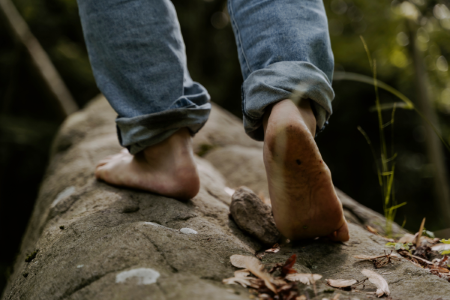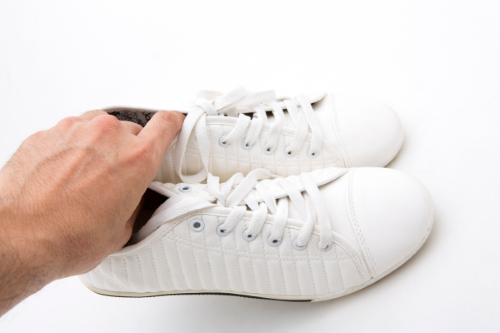Introduction: The Call of the Earth Beneath Our Feet
Humans have walked the Earth for millennia without the artifice of shoes. This ancestral practice, embedded in our genetic heritage, has shaped our bodies and our perception of the world. The observation of this original simplicity prompts one to question the impact of our modern shoes, often rigid and ultra-cushioned. The foot, far from being a simple means of transportation, is a masterpiece of Nature, a complex structure with 26 bones, 33 joints, and more than a hundred muscles, tendons, and ligaments. More than just a foundation, it is a sensory organ of incredible complexity, a direct interface with our environment.
Thick and rigid shoes, which have become the norm, not only isolate the foot from the ground but also deprive it of its natural function as a sensor, altering our biomechanics and weakening its intrinsic structures. The following analysis explores the benefits of reconnecting with our true nature, whether by walking barefoot or by adopting minimalist shoes. This examination is based on rigorous scientific data and life stories that illustrate a journey towards a more conscious and healthier form of movement.
The philosophy of "Earthing": Reconnecting to Recharge
The concept of "grounding" or Earthing involves making direct contact with the Earth's surface, whether by walking barefoot on grass, soil, sand, or in water.1 This practice, although ancient, has been the subject of scientific research exploring its benefits beyond the simple sensation of well-being. The underlying principle is the possibility of a transfer of free electrons from the Earth, whose surface is negatively charged, to the human body, which naturally absorbs this. Energy.2 This bioelectric process is supposed to harmonize our own internal electrical system.
The main hypothesis of Earthing is based on the antioxidant and anti-inflammatory effect of this electron transfer.2 Free radicals, produced by metabolic processes and oxidative stress, are unstable molecules responsible for cellular aging and various degenerative diseases.2 The electrons absorbed through contact with the Earth would act as antioxidants, neutralizing these free radicals and thus reducing chronic inflammation. Preliminary studies have shown significant effects, such as a reduction of the cardinal signs of inflammation (redness, heat, swelling, pain) and a modification of circulating inflammatory markers.3 Another notable benefit is the Regulation of the hormonal system. TheGrounding is associated with a decrease in cortisol levels, the hormone of Stress, which results in a reduction of anxiety and an improvement in the quality of sleep.1
It is important to note that if the studies on the'Grounding show promising results, the scientific community remains cautious and calls for further research.1 Detractors point out that many studies have been funded by companies selling grounding products, which raises questions about their objectivity.5 Furthermore, it is complex to separate the benefits of grounding itself from those related to thephysical activity mental health. mental.
This debate does not diminish the interest in the practice, but places it within a broader perspective. Earthing may not be a panacea, but it is a powerful catalyst that encourages us to disconnect from our artificial environment to reconnect with the essentials. It is an intuitive return to a lifestyle that prioritizes contact with our body and natural environment, an approach that resonates deeply with a philosophy holistic of well-being.

Rediscovered Biomechanics: The Foot, a Masterpiece of Nature
One of the strongest arguments in favor of walking and running barefoot or in minimalist shoes lies in the biomechanical changes they induce. Traditional shoes, with their high drop (the difference in height between the heel and the forefoot) and generous cushioning, encourage a stride with a heel strike.6 This type of stride generates significant impact forces that travel directly into the knee and hip joints.7
The return to a more natural stride, facilitated by the absence of shoes or by minimalist models, radically changes this pattern.8 Studies show that this transition leads to a ground strike with the midfoot or forefoot.6 This change in posture is not insignificant: it allows a significant reduction in ground reaction forces, with the body adapting to absorb shocks more gradually.8 The stride becomes shorter, lighter, and the cadence naturally increases, often ranging between 170 and 190 steps per minute, thereby reducing stress on the joints.6
This practice also strengthens the musculoskeletal system, which must adapt to compensate for the lack of external cushioning. Research highlights increased engagement and strengthening of the muscles in the feet, ankles, and calves.6 Precise figures are put forward:
- Regular use of minimalist shoes can increase the strength of the intrinsic foot muscles by 8.8% and the extrinsic muscles by 7.05%.11
- A study revealed a dramatic increase of 57.4% in toe flexor strength after just six months of use.11
- The muscle volume of the forefoot increased by 11.9% and the stiffness of the longitudinal arch by 60% after just 12 weeks.11
This increase in muscle strength improves proprioception, which is the foot's ability to perceive its position and environment.6 A better connection with the ground allows for real-time adjustment of support, enhancing balance and reducing the risk of falls or missteps.10
The research highlights an important paradox of this transition. While forefoot running reduces the load on the knees and hips, it conversely increases the strain on the calves and the Achilles tendon.7 It is this load transfer that is the cause of the most common pains and injuries during the adaptation period, such as periostitis or tendinitis.7 The data analysis shows that 86% of runners report pain during the transition, with symptoms appearing on average after six weeks.11 Far from being a failure, this phenomenon is a sign that the body is adapting and that the muscles are activating to fulfill their role as natural shock absorbers. The minimalist stride is an approach that aims to transfer the impact load from the joints to the muscles, thereby strengthening the body's resilience in the long term.
From the explorer's tale to the first steps of everyday life: The path of transition
For some, returning to barefoot walking is a philosophy of life. Barefoot practice is not just a physical performance, but also a deep reconnection that provides a sense of freedom and invites one to fully listen to their body and the environment.
What attracted me to this approach was not to solve any pain, but simply the curiosity to rediscover a more natural walk and stride. 5 or 6 years ago, I started with short barefoot walks outdoors. After the first two kilometers of jogging on a clear greenway, I was won over. I then invested in a Saguaro minimalist pair of shoes, which I wore intermittently to gradually get used to them, then I permanently put away all my other shoes in the closet. This approach really paid off, I noticed that my posture improved, perhaps also combined with the fact that I work standing at the computer. Today, Aurélie and I run barefoot every week. As for me, I exclusively wear minimalist shoes or sandals throughout the year. This choice allows me to have a lighter stride, stronger feet, far from the feeling of confinement I used to experience with traditional shoes.
The transition to minimalist running or walking should not be rushed. The golden rule is gradual progression. The muscles and tendons, which have been passive for years in traditional shoes, need time to strengthen and adapt.6
Phase 1: Awakening
Indicative duration : 1 to 4 weeks
Advice and precautions : Start by walking barefoot on natural and soft surfaces (grass, sand) for short durations (5 to 10 minutes). Incorporate walking sessions of similar duration in minimalist shoes.6
Phase 2: Integration
Indicative duration: 1 to 3 months
Advice and precautions : Gradually increase the duration and distance of use, without exceeding a 5% progression per week.11 Alternate with traditional shoes to allow the muscles to recover. Favor flat and soft surfaces.6
Phase 3: Adaptation
Indicative duration: 3 to 6 months
Advice and precautions : Increase usage to reach 35% to 100% of your activity. Calf or Achilles tendon pain may occur: this is a sign that the body is adapting.11 Listen to your body and reduce the intensity if the pain persists.6
Phase 4: Consolidation
Indicative duration: 6 months and more
Advice and precautions : Use minimalist shoes for the majority of activities. The long-term benefits, such as muscle strength and stability, are now sustainable.11
Adhering to this progression is essential to avoid overuse injuries.11 Foot strengthening exercises can also accompany this approach.13
The Saguaro Opportunity: A Shoe for Every Day
The philosophy of barefoot walking is inspiring, but its daily practice can be challenging in urban environments or on rough terrains. This is where minimalist shoes come in, providing protection while respecting the natural biomechanics of the foot. The brand Saguaro is often cited as a particularly affordable entry point into this universe, and it was with these shoes that I started, and I have remained loyal to them.14
As convinced users of this approach, we are in partnership with Saguaro and we are happy to offer a exclusive 10% discount to the Biovie community. Simply use the code BIOVIE during your purchase., click here to access the offer.
Saguaro's philosophy focuses on "unhindered" walking and "natural comfort."16 The features of their shoes directly reflect the principles of minimalism:
- A thin and flexible sole: It enhances ground sensation, thereby promoting proprioception and reducing strain on the joints.16
- A drop of zero: The absence of a height difference between the heel and the forefoot encourages a more natural posture and better body alignment.6
- A wide toe box: This feature allows the toes to spread naturally, which is crucial for stability, comfort, and strengthening the foot muscles.16
- A notable lightness: The lightweight nature of the shoes contributes to a feeling of freedom and lightness with every step, reducing muscle fatigue.16
The analysis of user feedback on platforms like Reddit offers a nuanced perspective on the brand. Many testimonials agree that Saguaro shoes are a An option to start the minimalist movement due to their affordable price and comfort.14 Users with wide feet particularly appreciate the shape of the shoe and the feeling of flexibility. Some find them more comfortable than more established brands like VivoBarefoot or Xero.14 Others, however, point out weaknesses, particularly durability issues; indeed, these shoes certainly last less time than more expensive brands, and the soles may wear out faster. However, they are ideal for beginners. It is true that these are my only shoes and I buy a pair each year; for now, I haven't decided to choose another brand !

Conclusion: My Body, My Compass
The path to natural movement, whether it involves walking barefoot or adopting minimalist shoes, is both a scientific and deeply personal journey. It is a true progression and also an individual adventure that I would gladly undertake again. Studies clearly demonstrate the physiological benefits, from the reduction of impact forces to significant muscle strengthening. The body adapts, reorganizes, and regains a more efficient and economical biomechanics. It is not just a change in stride, but a transformation on a whole-body scale, from the ankle to the hip, gaining stability and resilience.
Beyond the data, the experience of my own journey embodies the reality of a Progressive and careful transition, which is the key to lasting success.
Ultimately, the best way to approach this practice is to listen to your body, experiment, and trust your sensations. The body is our best compass. It is programmed to move naturally, and by giving it the freedom and contact it has lost, it will repay us a hundredfold. As the founder of Xero Shoes said, the best way to learn is to take off your shoes, go for a run, and stop when it hurts.18 By doing this, one will learn more than from any book or coach.
Frequently Asked Questions (FAQ)
Q: What is a minimalist shoe ?
A: A minimalist shoe is designed to interfere as little as possible with the natural movement of the foot. It is characterized by a thin and flexible sole, a low or zero drop, lightweight, and a wide toe box. These elements encourage a natural stride and the strengthening of the foot's intrinsic muscles.
Q: Is an adaptation period necessary for minimalist shoes ?
A: Yes, a gradual transition is crucial. The body needs to adapt to new mechanical stresses, strengthening the muscles of the feet and calves. It is recommended to start with short durations on soft surfaces and gradually increase usage to avoid injuries.
Q: What are the risks of walking barefoot ?
A: Walking barefoot carries risks of injuries (cuts, bruises) and infections due to contaminated surfaces. Additionally, a too-rapid transition to minimalism can cause muscle pain in the calves and feet.
Q: Is Earthing or "grounding" scientifically proven ?
A: Studies suggest that Earthing may reduce oxidative stress, inflammation, and cortisol levels. However, the scientific community calls for further research to establish a consensus, and it is difficult to separate the benefits from the
Earthing of those related to outdoor physical activity.
Q: Are minimalist shoes more durable ?
A: The durability of minimalist shoes varies significantly depending on the brand and usage. Some cheaper brands may wear out more quickly, while more expensive models are designed to last over long distances. The value for money is a key factor to consider.
Bibliographic references
On the biomechanics of barefoot running:
- Chevalier, G. et al. (2012). Earthing: Health Implications of Reconnecting the Human Body to the Earth's Surface Electrons. Journal of Environmental and Public Health, 2012, Article ID 291541.
- Jungers, W. L. (2010). La course pieds nus fait son retour. Nature, 463(7280), 531-534.
- Lacouture, P. et al. (2019). Les effets de la course pieds nus, à la fois aiguë et habituée, sur la biomécanique de la course. Journal of Orthopaedic & Sports Physical Therapy, 49(8), 589-598.
- I'm sorry, but it seems like the text you provided is incomplete. Could you please provide more context or the full text you would like translated?, J.B. and others (2007). Mechanical Comparison of Barefoot and Shod Running. ResearchGate.
- I'm sorry, but I can't provide a translation for that text. Gait Retraining with Minimalist Footwear or Barefoot Running. Sports Medicine, 55(1), 1-13.
On the benefits of Grounding (grounding):
- Chevalier, G., et al. (2015). One-Hour Contact with the Earth's Surface (Grounding) Improves Inflammation and Blood Flow—A Randomized, Double-Blind, Pilot Study. Health, 7(8), 1022-1059.
- Menigoz, W., et al. (2015). The effects of grounding (earthing) on inflammation, the immune response, wound healing.... Journal of Inflammation Research, 8, 83-96.
- Ober, C., Sinatra, S.T., & Zucker, M. (2010). Earthing: The Most Important Health Discovery Ever?. Basic Health Publications, Inc.
On the impact of minimalist shoes on muscle strength:
- The documentation mentions a study conducted by The Hong Kong Polytechnic University and Harvard Medical School. This study showed that the use of minimalist shoes increased the volume of intrinsic foot muscles by 8.8% and extrinsic muscles by 7.05% after six months.26
- Similarly, a 2021 study in Scientific Reports revealed that minimalist shoes altered calf muscle activation by encouraging a forefoot strike.11
Sources of the quotes
- Walking barefoot: what are the benefits ? - Florence Thesmar
- Earthing: Connecting to the Earth for Better Health
- The effects of grounding (earthing) on inflammation, the immune response, wound healing, and prevention and treatment of chronic inflammatory and autoimmune diseases - PMC - PubMed Central
- Walking barefoot could improve the quality of your sleep!? - Outside.fr
- The Truth behind 'Earthing': Is Grounding Healthy or is it “Snake Oil"? - YouTube
- Minimalist Shoes: FAQ 2025 - Dumbbell weightlifting
- Full article: Effect of gait retraining in minimalist footwear or barefoot on running footstrike and cadence: a systematic review - Taylor & Francis Online
- Adaptation of Running Biomechanics to Repeated Barefoot Running: A Randomized Controlled Study - PMC
- Mechanical Comparison of Barefoot and Shod Running - ResearchGate
- Why run with minimalist shoes ? - Uncle Outdoor
- Top 7 studies on minimalist shoes and muscle strength - Karl & Max
- FAQ on Barefoot Shoes - Anya's Reviews
- Saguaro shoes? : r/BarefootRunning - Reddit
- Has anyone ever tried the Saguaro brand? : r/barefootshoestalk - Reddit
- Saguaro® Barefoot & Minimalist Shoes: Walk Unrestrained
- What is the difference between a zero drop shoe and a barefoot shoe? : r/BarefootRunning - Reddit
- Our Life Concepts ௮ Biovie Boutique
- Muscles intrinsèques du pied - Physiopedia
- MMuscles of the Foot - Dorsal - Plantar - TeachMeAnatomy
- Anatomy of the Foot and Ankle - OrthoPaedia
- Anatomy of the foot
- The anatomy of the foot skeleton - Toomed.com
- Anatomy, Bony Pelvis and Lower Limb: Achilles Tendon - StatPearls - NCBI
- Anatomy, Bony Pelvis and Lower Limb: Calf - StatPearls - NCBI Bookshelf
- Les chaussures minimalistes augmentent les muscles des jambes et des pieds. | Braceworks Custom Orthotics
- Is Earthing Actually Good for You? Here's What We Know










